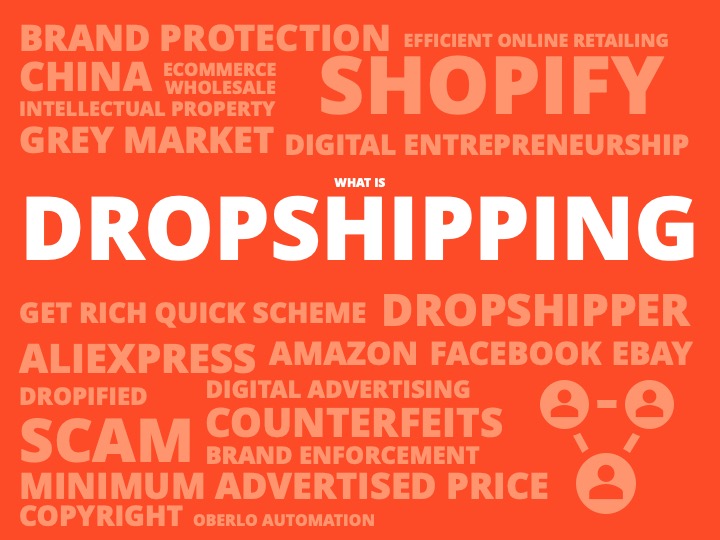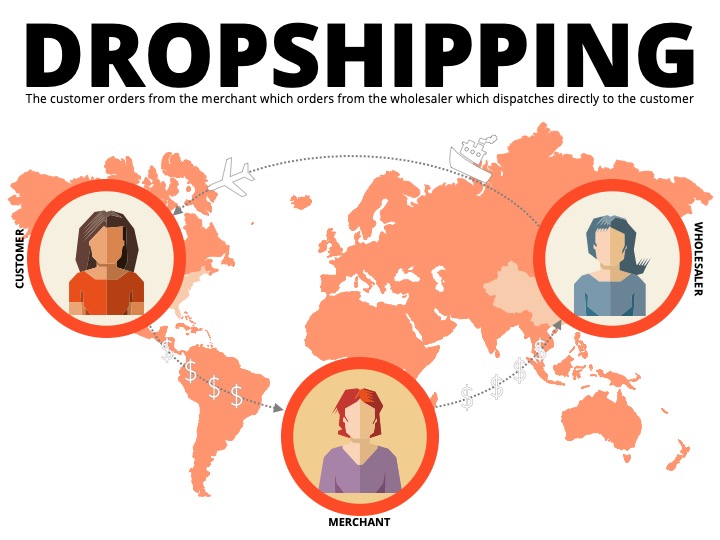What Is Dropshipping?
Dropshipping commonly features on ‘how to make money on the internet’ lists; the classic how-to article being another internet staple. It is seen as a method for budding digital entrepreneurs to get started in the lucrative world of ecommerce without significant upfront costs. A quick Instagram search for “dropshipping” reveals thousands of posts featuring items from high-end brands such as Rolex, Michael Kors and Audemars Piguet mixed in with motivational quotes about becoming a millionaire and images of supposed dropshippers standing next to expensive sports cars. YouTube is packed with clickbait tutorials for beginners to start out their very own dropshipping empire.
In its most basic form, dropshipping is an inventory-less form of retailing. The merchant advertises items for sale, which when ordered by a customer are purchased by the merchant from a wholesaler, which is sent directly from the wholesaler to the customer. The entire transaction process is completed without the merchant, often referred to as a dropshipper, holding any items in stock. Both merchant and wholesaler receive a cut of the revenue and the customer receives their items as ordered. Before turning to the potential brand protection issues, a quick look at the parties involved.

How Dropshipping Works
There are other methods for dropshipping which involve a different set-up. The focus of this description is on the Shopify-AliExpress tried and tested process.
The Customer
Customers are generally targeted on social media and redirected to the webstore of the dropshipper. Customers are often unaware they are ordering from a dropshipper rather than a more traditional retailing set-up. The dropshipper therefore takes responsibility for advertising the items, converting customers and the entire customer service process. Fulfilment By Amazon follows a similar model, enabling merchants to focus on selling and after-sales care, whilst Amazon handles the fulfilment process. Customers can wait over 20 days to receive their order, however, the growth of platforms such as Wish have shown ecommerce can be successful with relatively longer delivery times.
The Merchant
Merchants can be located anywhere in the world with an internet connection; another attractive element of the business to compliment the low start-up costs. Generally, merchants will target customers in the US – for a few reasons:
- The US is the largest retail market in the world.
- Lots of platforms and applications to automate the process of dropshipping to the US.
- Retail prices in the US are significantly higher compared to China.
- AliExpress offers competitive shipping price and delivery time to the US through ePacket.
The importance of ePacket shipping for dropshipping cannot be understated; it is a transparent process for shipping relatively small, low value items from China and Hong Kong to the US (and a few other lower priority countries on the dropshipping radar). Merchants generally source their items from China, specifically on AliExpress, given the low prices, low (and often zero) minimum order quantity and non-prohibiting shipping option.
Dropshippers benefit from not having to hold inventory, eliminating storage costs and the risk of unsold stock. Creating a Shopify webstore is the preferred method of choice, with platforms such as eBay and Amazon taking too great a cut on the already low margins of dropshipping. Shopify is a very powerful platform to efficiently build an ecommerce store, which can be customised and online in less than an hour. Traffic is driven to the webstore using social media, through Instagram and Facebook ads. Orders placed on the webstore can be automated using ‘Shopify Apps’ such as Oberlo or Dropified – these apps help the dropshipper add products to their webstore and automatically place the order with the wholesaler when received. The availability of apps and tools to automate the process is why many ‘online gurus’ list dropshipping as a low effort get rich quick scheme. Successful merchants spend their time on sourcing quality suppliers, producing and testing ads and building a brand. Brand building enables the dropshipper to sell the business, with high revenue webstores being sold for six figure amounts.
The Wholesaler
As mentioned above, AliExpress is the preferred choice for dropshippers to source items. Both wholesalers and manufacturers advertise on AliExpress, with many targeting dropshippers to sell their wares to an international market. Customers in the US and Europe are often still unaware of AliExpress, and those who have heard are likely to be put off by the widespread reporting of counterfeits being sold on AliExpress. Because otherwise, there is no explicable reason to not order directly from AliExpress – the customer receives the same product, shipped by the same seller at a far lower price; the price difference being the dropshipper’s cut of the transaction.

Dropshipping: The Brand Protection Perspective
Not all dropshippers sell counterfeits, or items which infringe any IP rights. However, given the extremely low barrier to entry into dropshipping, it has become a favourite tactic amongst counterfeiters. Speed plus low financial investment plus ineffectual content governance from intermediaries adds up to an ideal business model for counterfeiters.
Dropshippers will often turn to selling counterfeit items to increase the marketability and visibility of their webstores under the pretence of offering branded goods. The lure of the brand to customers, the credibility to the webstore from offering well-known brands and the exceptionally high profit margins drive the decision to list counterfeits by dropshippers. The sale of counterfeit items is not the only potential intellectual property issue detected within dropshipping, trade mark abuse, copyright and patent infringement are all common to the practice.
Most dropshippers will focus their webstore on a specific niche, tying together the domain name, website design and social media presence around the niche. Once the webstore is ready to start selling, the dropshipper will start an ad campaign, usually on Facebook. Branded and well-known products are seen as lower risk categories for paid ads, driving traffic and sales through the webstore without significant effort in the ad copy. Therefore, dropshippers often want to mix in a few branded items to draw traffic.
Sourcing branded goods at significant mark-downs is, unfortunately, a far harder task than sourcing counterfeits and knock-offs from the internet. Furthermore, generic items offered by dropshippers tend to have low profit margins, compared to counterfeit products, which attract higher margins.
Once customers have been enticed to the webstore via the social media ad campaign for the counterfeit item, the dropshipper can utilise Shopify apps to automate the cross-selling of other items, usually generic products, this enables the webstore to maximise revenue per customer. Even when the counterfeit item is removed from the webstore, running ads featuring the item can still drive traffic and therefore the chance to cross-sell generic items remains.
Brand Strategy For Enforcing Counterfeits From Dropshippers
Brands often ignore webstores with low visibility, measured by metrics such as Alexa rank, or search engine ranking. With dropshipping, such metrics are useless. It is common for the brand to only become aware of counterfeits being sold by dropshippers after receiving a customer complaint regarding a substandard product, which turns out to be a counterfeit purchased from a dropshipper.
It is vital to prevent knockoffs stealing sales and damaging brand equity.
Webstores of dropshippers typically rely on delivering targeted ads on social media, honing their niche with iterative advertising campaigns to amplify efficacy. The ads aim to grab user attention through the use of striking images, bold text and grand proclamations i.e. healing crystals advertised using side-by-side comparison of a healthy, semi-naked person standing next to an emaciated corpse with some vague healthcare statistics flashing across the ad proclaiming the benefits of the crystal.
In many ways social media has become the battleground for politics, culture and ecommerce. Brands which utilise social media influencers or digital advertising will fail to have their brand voice heard if they do not effectively undertake brand enforcement on key platforms to protect against dropshippers from infringing their intellectual property rights.
Six Steps To Enforce Dropshippers Offering Counterfeits:
1) Have the dropshipper remove the infringing item
An assessment of the webstore should be made, if the dropshipper is running a legitimate webstore but has inadvertently included a copycat product, then a polite message through the ‘Contact Us’ form will generally suffice to remove the infringing item from the webstore and ads featuring the item.
2) Report the ad
Immediately report the ad to Facebook, as the traffic from the ad campaign is likely to be the biggest driver of customers to the counterfeit item. Due to constant scandals and demands for transparency regarding the ad supply chain, Facebook has increased the handling time for reported ads. Removing the ad cuts the revenue stream and therefore reduces the commercial viability of selling the counterfeit. Facebook has a tool which brand owners can use to monitor ads which potentially infringe their trade marks; therefore, monitoring new ads and taking swift action can often prevent customers from purchasing the counterfeit item and the inevitable customer complaints which follow.
3) Notify Shopify
Use a Whois search to identify if the webstore is indeed using the Shopify platform, if so, locate the counterfeit abuse form on Shopify’s website and report the item to be removed. Shopify can be slow to respond but will takedown counterfeit items, or items infringing copyright, such as using official copyright-protected imagery. This increases the importance of removing the ads driving traffic to the webstore and counterfeit item, as the counterfeit is likely to remain online for a week after being reported for removal. Shopify, unfortunately, does not enforce a repeat infringer policy for sellers of counterfeits who abuse their platform, therefore it is best practice to monitor known counterfeit sellers to identify and enforce infringing content immediately.
4) Find the source
As mentioned above, dropshippers tend to use AliExpress to source items. Therefore, copy the product listing title and enter it into AliExpress. Alternatively, perform a reverse image search on the product items to find the source. This can easily be done by right clicking the item and selecting ‘Search Google for Image” option. There are also browser extensions to search AliExpress for images which can be used for this purpose. Once the original listing on AliExpress has been detected, send a takedown notice to Alibaba to have the counterfeit item removed. This stops the supply-line of the dropshipper and any other potential dropshipper from offering the item in future. Fortunately, AliExpress is very responsive to correctly filed takedown notices, typically removing items within 24 hours – but the takedown process can be difficult to understand for brands with no experience of their takedown process.
5) Search for other examples of brand abuse
When conducting the reverse image search, other ecommerce sites may appear in the results. Takedown notices should be sent for all relevant results. Searching directly on popular ecommerce platforms, such as Amazon or eBay should be conducted using the product title, or slight variations to ensure all infringements are detected for removal. For all infringing merchants detected, their entire store should be checked to detect any other infringing items available for sale.
6) Set alerts
If the counterfeit item is detected on a popular platform such as Amazon, then a product alert can be set up to monitor for future infringements. There are numerous extensions and applications that will monitor and send an alert via email for this purpose. It is best practice to have a separate email account for such alerts which is monitored regularly. If the item does re-emerge, then be sure to head back to AliExpress to identify and remove the new source of the counterfeits entering the market.
With a methodical approach to detecting, removing and monitoring intellectual property infringements occurring from dropshippers, brands can prevent brand dilution and maximise their digital channels of consumer engagement.
Useful resources:
https://www.shopify.com/legal/trademark-infringement



